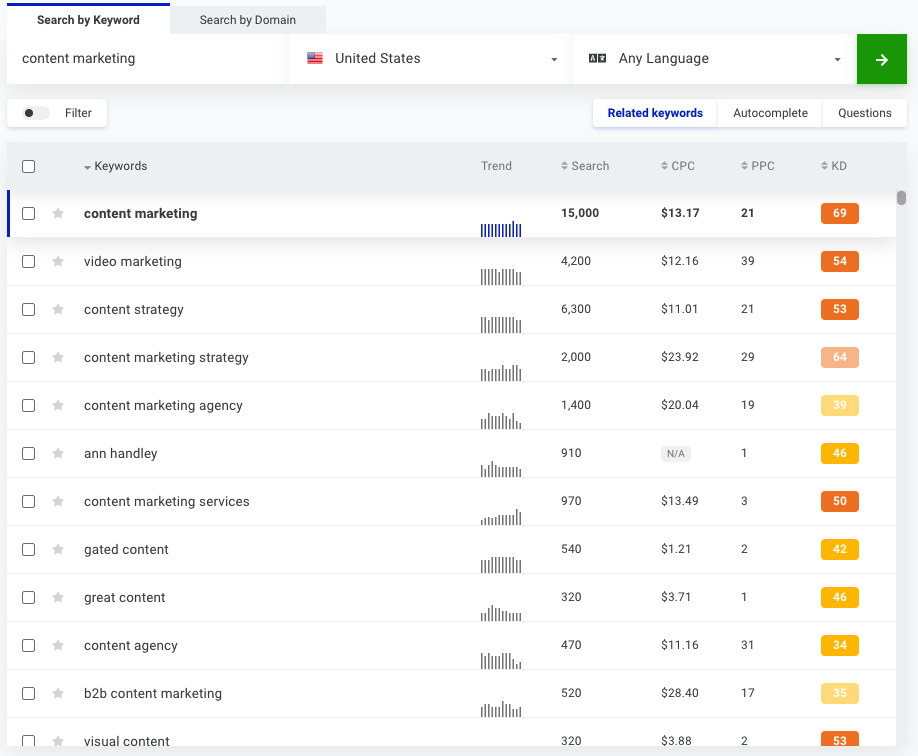There’s a reason why content marketing isn’t simply called “content.” You can’t see successful results with your webpages and blog posts if you don’t have a marketing plan behind their content.
Too many digital marketers assume that simply writing good content will bring site visitors to them. While that may be the case for established websites with strong domains and social media followings, smaller websites with little to no authority can’t compete on good content alone. Especially not in search engine results.
Content that performs well in search engine results often has a search engine optimization (SEO) plan backing it, typically in the form of a comprehensive keyword strategy. We’re not talking repeating a word or phrase a few times in various places throughout a body of text. A true strategy involves in-depth keyword research and audience analysis that ultimately places your content in front of the right audience at the right time.
How can you put together this strategy? We’ll walk you through it.
How to Do Keyword Research for Content Marketing
To best explain how we approach a comprehensive keyword strategy with our content marketing efforts, we’ll use an example. Let’s say we’re writing a blog post titled “Content Marketing Tips & Tricks for Beginners.” We know we want to target an audience that consists of professionals who are new to the digital marketing industry and businesses that are trying to create content for their websites.
The tools we’ll use to put together this keyword strategy are Google, KWFinder (an SEO tool), and Keyword Tool (a free Google keyword suggestions tool). First, we’ll start by defining our main keyword. From there, we’ll find related keywords, semantically relevant words, long-tail keywords, and user-intent phrases.
Start with a Broad Keyword That Matches Your Subject
Let’s assume that our broad keyword is content marketing, as it’s the main subject of our example post. Using KWFinder, we’ll look at how many searches it gets each month to confirm it’s worth targeting.

We can see that content marketing as a phrase-match keyword (i.e., a direct match) has a search volume of 15,000. Since this is such a strong keyword, it’s important to include it in important areas of our content: the post title, the SEO title, the meta description, the URL, and the body copy.
But because content marketing gets 15,000 searches every month, it’s also a highly competitive keyword. In other words, if we were to only utilize this keyword, it would be more difficult to compete with other websites in search engine results that are targeting the same keyword—especially if those other websites have stronger domains and receive more clicks. This is where including more keywords can help.
Look at Related Keywords & Semantically-Relevant Words
Adding variations of our main keyword makes it easier for search engines to understand what our content is about beyond the broad topic. This not only helps our content compete more effectively in search engine results, but it also means search engines will know to show our post for certain content marketing search queries (and not others), thereby putting us in a better position to reach our intended audience.

If we look at related keywords in KWFinder, we’ll see variations like content marketing strategy and content strategy. These could easily be worked into the body copy of our post. Even keywords that have fewer monthly searches, like content marketing services, can provide value because they’re less competitive and add context that can help search engines understand our content’s goal and the audience we’re targeting.
We can also come up with words that are semantically related to our main keyword—as well as words related to those used in our title—that further the contextual understanding for search engines. For example:
- amateur
- articles
- beginner
- blogging
- content
- copywriting
- digital
- hacks
- keyword
- marketing
- media
- online
- plan
- SEO
- social
- strategy
- tips
- tricks
- webpage
- website
- writing
By including these throughout our content (where they fit naturally, of course), we can send signals to search engines scanning the text that our “Content Marketing Tips & Tricks for Beginners” post covers content marketing as it relates to these ideas.
But we shouldn’t stop there. We can go a step further with our keyword optimization efforts.
Target Long-Tail Keywords & User-Intent Phrases
Search engines have become so sophisticated with semantic search that it’s easier than ever to target audiences who are looking for something in particular using long-tail keywords and user-intent phrases. Think of this step as more of an audience analysis because we’re researching what it is our audience is trying to find and how they go about finding it through search.
We’ll start by using Keyword Tool to find long-tail keywords around our main keyword. Try a few variations to see what comes up. In the example below, we use content marketing tips.

Here, we see a long-tail keyword that aligns with our post title: content marketing tips and tricks. This means our post title is well-optimized. We also see a more targeted aspect of content marketing: content marketing tips for writers. If we want to focus specifically on writing tips in content marketing, this would be a good long-tail keyword to use. We also see audience-specific long-tail keywords—content marketing tips for small businesses, b2b content marketing tips—that would be beneficial if our audience consists of businesses.
User-intent phrases are more complicated to incorporate because they’re rooted in question/answer or problem/solution searches, which means we have to anticipate what it is our audience wants or needs from our content. For example, if a searcher types “how to” followed by a verb like “write” or “create, ” the search engine will suggest several options that follow based on what it thinks the user is looking for.
We can find user-intent phrase suggestions among KWFinder related keywords or Keyword Tool long-tail keywords, such as what is content, what is a content marketing strategy, and content marketing tips for small businesses. But the best way to find them is to simply conduct Google searches. We can try a variety of related terms and long-tail keywords to see what comes up.


We can also scroll to the bottom of Google’s search engine results to the related searches section. This section won’t always have queries that are useful for user-intent phrases, but it will give us an idea of what our audience is looking for, including words they use, such as best, top, and successful.

While we can implement long-tail keywords and user-intent phrases in body copy, they’re better utilized in header tags (h1s, h2s, h3s, etc). Header tags are important for on-page SEO, and they typically hold more weight than body text, so search engines are more likely to pick up on long-tail keywords and user-intent phrases in your content if they’re in on-page headings.
Is Keyword Research Really Worth the Time & Effort?
Building a comprehensive keyword strategy can be daunting. It’s a lot of research and analysis for what might only turn out to be a 500-word blog post. But remember…it doesn’t matter how well-written your content is if your audience can’t find it. Content marketing and SEO have to work together. By putting in the work upfront, you can craft better content that not only attracts more site visitors, but more site visitors who could become converting customers. And that is the goal of content marketing after all, isn’t it?



